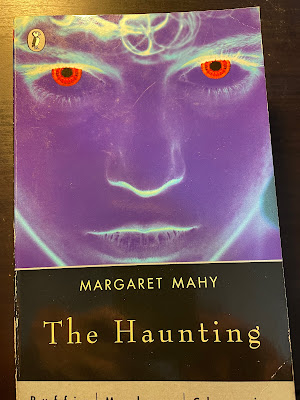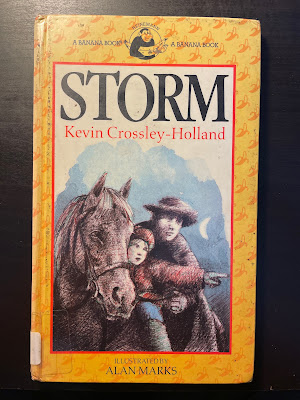Everyday Magic
This Carnegie Medal reading project is starting to make me feel old. In 1982 Margaret Mahy won with The Haunting. I'd been thinking that now we were in the 1980s I'd be starting to read more books by authors who are still very familiar to readers today, and then I realised that this book was published 40 years ago.
When I was a primary school teacher back in the 1980s Margaret Mahy's picture books, like The Lion in the Meadow and The Man Whose Mother Was a Pirate were much-read fixtures in our classrooms, but I never read her books for older children and young adults at the time. I probably would have read them, but for my aversion to ghost stories, and that's a shame because Mahy writes about the supernatural like nobody else I know. Actually, Mahy writes like nobody else I know. I am an inveterate skipper and skimmer of text but I promise you I read every single word of this book because every single word is so brilliant. Look at how she describes what's going on inside the haunted Barney's head:
'Sometimes he thought that there was a mountain inside his head with many roads winding up and down around it. His thoughts were like different coloured cars zigzagging backwards and forwards, often unseen and then sometimes showing up on some clear corner. There went his worry about the ghost—there went his happy feeling about home. Sometimes a thought would suddenly appear from a gully or out of a forest and surprise him, because he hadn't known it was there.'
With Mahy you simply accept the magic and the magicians (who live ordinary lives in ordinary houses) as part of normal life and although magic is seamlessly integrated into the book's structure it is essentially about children coping with bereavement (their mother is dead) and learning to live with a new stepmother and the birth of a new sibling. Two years later Mahy won the Carnegie again with The Changeover, a novel for slightly older readers with a similar blend of magic and family life which is also a terrific read.
Foolishly I got carried away a few months back and read both of Margaret Mahy's winners, only to discover when I came to write about them this week that I could remember almost nothing about them beyond the fact that I loved them. I had to do a quick bit of rereading, and luckily they were just as good the second time around.
In between these two winners Jan Mark also won for a second time with Handles, a wonderful book about which I wrote in a post on this blog a few years back. It was a good few years for the Carnegie. Then, in 1985, the prize went to Storm by Kevin Crossley-Holland. This very short text is a ghost story about a little girl who has to go out in a storm and fetch the doctor when her mum is about to give birth. I have absolutely no idea why the committee considered Storm worthy of the Carnegie Medal. I know I've gone on before about the importance of these books for the very youngest independent readers, but it seems weird to me that this book should be the one to have won.
For a start, the plot is very similar to that of Jane Gardam's Bridget and William. It just has an added and not very convincing ghost rider to take the little girl to the doctor. It also contains this simile on the second page which I challenge anyone to explain: 'And since his stroke, her father was only able to walk with the help of two sticks. He had become quite mild and milky, like grain softened by mist.' What does that mean? Every time I read it I try to figure it out, but I can't. What a seven-year-old would make of it, I can't imagine.
The only review of this book on Amazon says it's good to 'use' with Y2/3 children. I dare say that's true. It's full of the kind of writing some teachers long for their pupils to produce, and reviewers on Goodreads single out for praise things that make me shudder (and not in the intended way). eg 'Empty it looked and silent it seemed.' Anyway, you'll gather that I didn't like it. It feels slight, incomplete and over-written. More than that, I greatly regret that it was preferred to Janni Howker's The Nature of the Beast. Janni Howker was a perpetual runner-up for the Carnegie, about whom I have written elsewhere. I should also say that I admire much of Kevin Crossley-Holland's other work, especially his version of The Norse Myths.
Finally this month I have to say something about a guide to the Carnegie winners that I found a reference to on a blog somewhere. The book is called Outstanding books for children and young people: The LA guide to Carnegie/Greenaway winners 1937-1997 and it was published in 1998 by the Library Association. 'That looks useful,' I thought, so I had a look for it online only to discover that it was rare and very expensive—about £90. So I went into the British Library where I had learned that it was on open access on the shelves. I set about looking for what I assumed would be an enormous hardback and couldn't find it until I noticed a very slim, small paperback sandwiched between other books.
I sat down to read. There are some glaring inaccuracies in the book which I was going to write about until I realised that its author, Keith Barker, died suddenly just a year after the book was published. He was only 51. I don't know if he was ill at the time, but someone really should have noticed important errors in the descriptions of both The Scarecrows and The Haunting. I'd recommend that you don't splash out £90 on this.
And that's it for another month. Four Carnegie winners in one post! I might actually get to the end as long as I don't have to read all of them twice.
Originally published on ABBA December 2022







Comments
Post a Comment